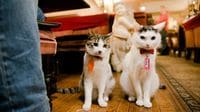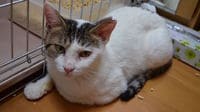Cleanliness is one of the biggest selling points of cats as pets—particularly their ability to use a litter box without training. However, it is still the human owner’s job to clean these litter boxes, and it must be done frequently. Inventors have come up with a number of innovative litter box designs and cat litters in pursuit of quicker and more-efficient cleaning operations, culminating in the debut of the Litter-Robot Open-Air, a line of self-cleaning litter boxes developed in U.S.
OFT, an import and sales company in Japan, offers these products to customers domestically. An earlier version of the Litter-Robot Open-Air earned roughly 1,000 favorable reviews on the American shopping site Amazon.com, and the newest release is an upgrade to that already-popular product.
A nightlight, which goes on when the room gets dark to improve litter box visibility for humans, is an addition seen in the new model. The entrance was enlarged so cats can go in and out more easily, and the overall design has been revamped so the product doesn't appear unrefined or out of place inside the home. The 98, 000-yen price may seem steep for a litter box, but it has been selling smoothly since its May release.
The sensors detect a weight change when the cat finishes his or her business and exits the Litter-Robot Open-Air, causing the interior section to rotate automatically in response. This removes clumped litter (urine) and feces and returns unused litter to the litter box. The extracted waste moves to a pullout section at the base of the box, and as long as owners insert a plastic bag in advance, they can remove and dispose of the excrement without dirtying their hands.
Cat ownership growing in Japan
This product is something any cat owner would be happy to have, and cat ownership numbers and overall cat popularity are rising rapidly in Japan. In recent years, cat lovers (including this author) have witnessed a dizzying proliferation of feline appearances on TV shows and in commercials, manga, movies, and other media. Although it initially seemed as if this were part of some greater marketing scheme, contemporary social circumstances actually played a major part.
According to an October 2015 survey conducted by the Japan Pet Food Association, approximately 9.917 million dogs and 9.874 million cats live as pets in Japan. Although dogs were once far more popular among Japanese pet owners, cats are poised to overtake dogs in the near future.
Apparently, this is partially due to changes in their owners’ lifestyles. One factor is the increasing concentration of people in urban areas, which led to more apartment complexes and a resulting preference for cats over dogs, because cats can easily live indoors.
In addition, owners must walk dogs, and their barks and howls require sufficient space between one's home and the home of one's neighbors. Cats, on the other hand, don't need to go on walks, and they don't make loud noises. Furthermore, the growing number of single people who are often away from home for extended periods and elderly residents who aren't able to get around easily anymore means that cats, who don't require as much work or attention, are increasingly favored.
Rise of Nekonomics
Great things are expected in terms of economic benefits resulting from this boom in feline popularity. The current administration’s policies (Abenomics) are beyond help; in contrast, the positive economic benefits of "Nekonomics" (a combination of “neko,” meaning cat, and “economics”) appear to be quite significant.
A feline celebrity named Tama inspired the word Nekonomics. She was a rescue from the streets and was called the stationmaster of the Wakayama Electric Railway’s Kishi Station. She died in June 2015. The overall economic benefits of "hiring" Tama to promote the railway reached a staggering 1.1 billion yen.
According to Katsuhiro Miyamoto, an honorary professor at Kansai University, Nekonomics’ benefits were approximately 2.3 trillion yen in 2015, which accounts not only for profits made from purchases of cat food and other supplies, but also encompasses sales of cat-related publications and other products as well as sales from cat cafes, cat-related tourism, and other such businesses. Compare this with the 3 trillion yen the 2020 Tokyo Olympic and Paralympic Games is expected to generate, and it's easy to grasp the massive impact of Nekonomics.
Japanese culture views cats as symbols of good fortune and financial prosperity. Maneki-neko, often called "lucky cats" or "beckoning cats" in the English-speaking world, are figurines installed in shops everywhere as talismans for commercial success. Today, it seems as if real-life maneki-neko have become lucky charms for greater prosperity throughout the Japanese economy as a whole.




